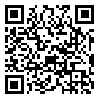Volume 18, Issue 19 (7-2020)
RSMT 2020, 18(19): 113-126 |
Back to browse issues page
Download citation:
BibTeX | RIS | EndNote | Medlars | ProCite | Reference Manager | RefWorks
Send citation to:



BibTeX | RIS | EndNote | Medlars | ProCite | Reference Manager | RefWorks
Send citation to:
Mirdar Harijani S, Musavi N. The effect of 12 weeks of submaximal swimming training on immunoreactivity of Ras and Raf-1 in lung epithelial cells of Wistar rats exposed to carcinogen NN. RSMT 2020; 18 (19) :113-126
URL: http://jsmt.khu.ac.ir/article-1-438-en.html
URL: http://jsmt.khu.ac.ir/article-1-438-en.html
, narciss.mousavi61@gmail.com
Abstract: (6930 Views)
The aim of this study was to investigate changes in immunoreactivity of Ras and Raf-1 in lung epithelial cells of rats exposed to carcinogen NNK after swimming training. 50 Wistar rats were randomly divided into five groups: control, training, training + NNK, NNK and sham. NNK-induced groups received NNK Subcutaneously once a week at a dose of 12/5 mg per kg body weight for 12 weeks. The exercise training consisted of submaximal swimming training for 12 weeks. The percentage of reaction of Ras and Raf-1 in lung epithelial cells were measured by HIC. It was observed no significant change in the Ras and Raf-1 immunoreactivity of lung epithelial cells in training group compared to control. A significant incretion of the Ras and Raf-1 immunoreactivity was found in NNK group compared to control group (p=0.001). Furthermore, a significant reduction of the Ras and Raf-1 immunoreactivity was observed in exercise + NNK group when compared to NNK group (p=0.001). Generally it could be confirmed that regular submaximal aerobic training plays an important role in inhibition of the effects of lung carcinoma induced by NNK via reduction of Ras and Raf-1 activity.
Type of Study: Research |
Received: 2020/07/19 | Accepted: 2020/07/15 | Published: 2020/07/15
Received: 2020/07/19 | Accepted: 2020/07/15 | Published: 2020/07/15
References
1. Hecht. S.S., Murphy, S.E., Carmella, S.G., Li, S., Jensen, J., Le, C., Joseph, A.M., Hatsukami, D.K. (2005). Similar uptake of lung carcinogens by smokers of regular, light, and ultralight cigarettes. Cancer Epidemiology and Prevention Biomarkers. 14(3):693-8. [DOI:10.1158/1055-9965.EPI-04-0542]
2. Jin, Z., Gao, F., Flagg, T., Deng, X. (2004). Tobacco-specific nitrosamine 4-(methylnitrosamino)-1-(3-pyridyl)-1-butanone promotes functional cooperation of Bcl2 and c-Myc through phosphorylation in regulating cell survival and proliferation. The Journal of Biological Chemistry. 279(38):40209-19. [DOI:10.1074/jbc.M404056200]
3. Panani, A.D., Roussos, C. (2006). Cytogenetic and molecular aspects of lung cancer. Cancer Letters. 239(1):1-9. [DOI:10.1016/j.canlet.2005.06.030]
4. Witschi, H. (2004). Carcinogenic activity of cigarette smoke gas phase and its modulation by beta-carotene and N-acetylcysteine. Toxicological Sciences. 84(1):81-7. [DOI:10.1093/toxsci/kfi043]
5. Xue, J., Yang, S., Seng, S. (2014). Mechanisms of cancer induction by tobacco-specific NNK and NNN. Cancers. 6(2):1138-56. [DOI:10.3390/cancers6021138]
6. Schaal, C., Chellappan, S.P. (2014). Nicotine-mediated cell proliferation and tumor progression in smoking-related cancers. Molecular Cancer Research. 12(1):14-23. [DOI:10.1158/1541-7786.MCR-13-0541]
7. Akopyan, G., Bonavida, B. (2006). Understanding tobacco smoke carcinogen NNK and lung tumorigenesis (Review). International Journal of Oncology. 29(4):745-52. [DOI:10.3892/ijo.29.4.745]
8. McCubrey, J.A., Steelman, L.S., Chappell, W.H., Abrams, S.L., Wong, E.W.T., Chang, F., Lehmann, B., Terrian, D.M., Milella, M., Tafuri, A., Stivala, F., Libra, M., Basecke, J., Evangelisti, C., Martelli, A.M., Franklin, R.A. (2007). Roles of the Raf/MEK/ERK pathway in cell growth, malignant transformation and drug resistance. Biochimica et Biophysica Acta (BBA)-Molecular Cell Research. 1773(8):1263-84. [DOI:10.1016/j.bbamcr.2006.10.001]
9. Widegren, U., Wretman, C., Lionikas, A., Hedin, G., Henriksson, J. (2000). Influence of exercise intensity on ERK/MAP kinase signalling in human skeletal muscle. Pflügers Archiv. 441(2-3):317-22. [DOI:10.1007/s004240000417]
10. Xie, L., Jiang, Y., Ouyang, P., Chen, J., Doan, H., Herndon, B., Sylvester, J.E., Zhang, K., Molteni, A., Reichle, M., Zhang, R., Haub, M.D., Baybutt, R.C., Wang, W. (2007). Effects of dietary calorie restriction or exercise on the PI3K and Ras signaling pathways in the skin of mice. Journal of Biological Chemistry. 282(38):28025-35. [DOI:10.1074/jbc.M604857200]
11. Su, S.H., Jen, C.J., Chen, H, (2011). NO signaling in exercise training-induced anti-apoptotic effects in human neutrophils. Biochemical and Biophysical Research Communications. 405(1):58-63. [DOI:10.1016/j.bbrc.2010.12.123]
12. Urrego, D., Tomczak, A.P., Zahed, F., Stühmer, W., Pardo, L.A. (2014). Potassium channels in cell cycle and cell proliferation. Royal Society. 369(1638):194-203. [DOI:10.1098/rstb.2013.0094]
13. Ferioli, M., Zauli, G., Martelli, A.M., Vitale, M., McCubrey, J.A., Ultimo, S., Capitani, S., Neri, L.M. (2018). Impact of physical exercise in cancer survivors during and after antineoplastic treatments. Oncotarget. (17):14005-34. [DOI:10.18632/oncotarget.24456]
14. Belinsky, S.A., Foley, J.F., White, C.M., Anderson, M.W., Maronpot, R.R. (1990). Dose-response relationship between O6-methylguanine formation in Clara cells and induction of pulmonary neoplasia in the rat by 4-(methylnitrosamino)-1-(3-pyridyl)-1-butanone. Cancer Research. 50(12):3772-80.
15. Mirdar, Sh., Arab, A., Hedayati, M., Hajizade, A. (2011). The effect of pregnant rat swimming on hypoxia-inducible factor-1α levels of neonatal lung. Tehran University Medical Sciences 69(12):754-60. (Persian)
16. Khodaie, B., Lotfinia, A.A., Ahmadi, M., Lotfinia, M., Jafarian, M., Karimzadeh, F., Coulon, Ph., Gorji, A. (2015). Structural and functional effects of social isolation on the hippocampus of rats with traumatic brain injury. Behavioural Brain Research. 278:55-65. [DOI:10.1016/j.bbr.2014.09.034]
17. Dasgupta, P., Rastogi, S., Pillai, S., Ordonez-Ercan, D., Morris, M., Haura, E., Chellappan, S. (2006). Nicotine induces cell proliferation by β-arrestin-mediated activation of Src and Rb-Raf-1 pathways. The Journal of Clinical Investigation. 116(8):2208-17. [DOI:10.1172/JCI28164]
18. Improgo, M.R., Tapper, A.R., Gardner, P.D. (2011). Nicotinic acetylcholine receptor-mediated mechanisms in lung cancer. Biochemical Pharmacology. 82(8):1015-21. [DOI:10.1016/j.bcp.2011.05.020]
19. Wen, J., Fu, J.H., Zhang, W., Guo, M. (2011). Lung carcinoma signaling pathways activated by smoking. Chinese Journal of Cancer. 30(8):551-8. [DOI:10.5732/cjc.011.10059]
20. Testa, J.R., Tsichlis, P.N. (2005). AKT signaling in normal and malignant cells. Oncogene. 24(50):7391-3. [DOI:10.1038/sj.onc.1209100]
21. Jost, J., Weiss, M., Weicker, H. (1989). Comparison of sympatho-adrenergic regulation at rest and of the adrenoceptor system in swimmers, long-distance runners, weight lifters, wrestlers and untrained men. European Journal of Applied Physiology and Occupational Physiology. 58(6):596-604. [DOI:10.1007/BF00418505]
Send email to the article author
| Rights and permissions | |
 |
This work is licensed under a Creative Commons Attribution-NonCommercial 4.0 International License. |







